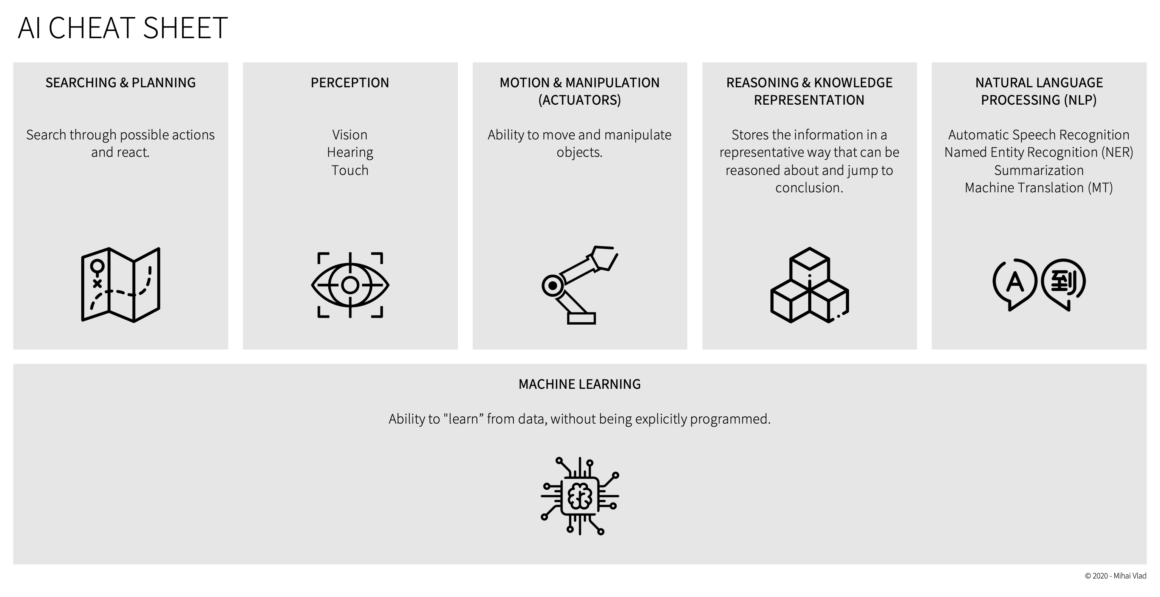In very simple terms, Artificial Intelligence (AI) is our ambition to get machines to perform cognitive tasks.
To understand what these cognitive tasks are, let’s use an example:
You started planning your first ever trip to Paris, and you’re looking for travel advice. Luckily, your friend Jacques who grew up in Paris, offered to help.You’re just about to meet Jacques for a coffee. As you get out of your Über, you see him waiting outside. You wave to say hello and he waves back. Lattes and Flat Whites are ordered and you start jotting down the patisseries serving perfect croissants, the “arrondissements” to explore, and you finally learn how to say “Bonjour” with the right amount of “rrrr”. Fully caffeinated and pleased with the intel gathered, you thank Jacques and promise to return the favour whenever he’ll visit your hometown.
So let’s break this down into tasks, and see how AI is trying to perform them.
- Before meeting Jaques, you had to figure out how to get to the coffee shop. As it was too far away to walk to, you decided to call an Uber. This is a Searching and Planning challenge, and AI is aiming to solve it. Both you and the Uber driver are using AI to find the fastest path through ever changing traffic.
- When getting out of the car, you quickly identified Jaques, out of all the people passing by. This was effortless, thanks to millions of years of evolution. Perception, and especially Vision are key areas of focus in AI. The Facial Recognition feature available in digital cameras is a good good indication of where the technology is today. The same technology is enabling Autonomous Vehicles (like Tesla) to detect pedestrians and maintain the distance from the other cars.
- Waving your hand to say Hello was also an effortless task. And it was clearly understood by Jaques. Not so effortless for machines. That’s why AI has a sub-filed focused on Motion and Manipulation developing technologies used by robotic arms or medical robots.
- When listening to Jacques, you were able to distinguish every word he was saying, summarise the ideas and even transcribe some of Jacques words on paper. Humans can do this after 1 year of training in primary school. Machines are also getting better at these types of tasks, thanks to the evolutions in Natural Language Processing (NLP). This sub-filed of AI includes technologies like Automatic Speech Recognition (ASR), used in smartphones or by Virtual Assistants like Siri.
- You probably knew what a croissant was, but Jaques had to explain that “arrondisment” is the French equivalent of a neighbourhood. You are now able to express the same concept in two different languages. AI is taking a stab at that, through Machine Translation (MT). To be able to get a machine to understand a block of text, extract it’s meaning and almost miraculously transfer that meaning in another language, in a properly formatted sentence is quite mind boggling. But this technology is live today, and while not perfect, the results can be quite impressive. That’s why, out of all the AI applications, Machine Translation is considered the most complex, and labeled by experts as AI Complete. Some of the most recent advancements of this technology are impressive, especially when applied to complex languages like Russian.
- When you got home, you might have looked at the notes you scribbled, and easily distinguished the words even if you are not a master calligrapher. AI is also enabling machines to do the same thanks to Optical Character Recognition (OCR) technologies. This is used today by the postal service to quickly sort out mail, by reading human written addresses. The results are impressive.
The examples above are just a small cross section of all the AI applications.
There is, however, a key area which needs to be mentioned. That is Machine Learning. As humans, we learn how to play football, ride a bicycle, drive a car, sail a boat, play the guitar, and even speak more than one language. We are not born or pre-programmed with these skills, and yet, with practice we are able to master them. To get machines to learn is a key area of focus of AI. More about Machine Learning in a future post.
Until then, here is a quick AI cheat sheet.

À la prochaine.






